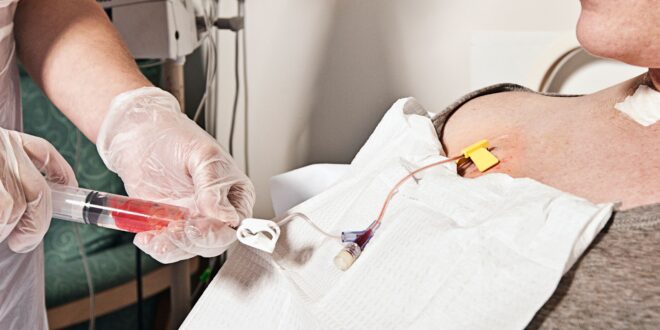Breast cancer is one of the most common cancers affecting women worldwide, and treatment options vary depending on the stage, type, and overall health of the patient. Among these options, chemotherapy remains a cornerstone of treatment, especially for patients with aggressive or advanced disease. One of the most frequently asked questions by patients is: how long is chemo treatment for breast cancer?
Understanding the duration and process of chemotherapy can help patients and families prepare mentally, emotionally, and physically for the journey ahead. This article will provide a detailed explanation of chemotherapy for breast cancer, including its types, risk factors, symptoms, diagnosis, treatment plans, and supportive measures that can improve both outcomes and quality of life.
Definition and Overview
Chemotherapy, often referred to as “chemo,” is a systemic cancer treatment that uses powerful drugs to target and destroy rapidly dividing cancer cells. In the context of breast cancer, chemotherapy can be administered before surgery (neoadjuvant therapy), after surgery (adjuvant therapy), or for advanced cases where the cancer has spread.
The duration of chemotherapy depends on several factors, including the stage of breast cancer, the type of drugs used, and the patient’s overall health. On average, chemo treatment for breast cancer lasts between three to six months, although some regimens may extend up to a year.
Types
Chemotherapy for breast cancer is not one-size-fits-all. Different regimens and combinations are tailored to each patient:
- Adjuvant chemotherapy: Given after surgery to reduce recurrence risk.
- Neoadjuvant chemotherapy: Administered before surgery to shrink tumors.
- Metastatic chemotherapy: Used when breast cancer has spread beyond the breast and lymph nodes.
- Combination chemotherapy: Involves using more than one drug for higher effectiveness.
Causes and Risk Factors
Breast cancer develops due to genetic mutations that cause abnormal cell growth. While the exact cause is often unknown, several risk factors increase susceptibility:
- Genetic mutations (BRCA1, BRCA2, and others)
- Family history of breast cancer
- Hormonal influences (early menstruation, late menopause, hormone replacement therapy)
- Lifestyle factors (obesity, alcohol consumption, lack of physical activity)
- Age and gender, with women over 40 being more at risk
Symptoms and Early Warning Signs
Early detection of breast cancer can significantly improve survival rates. Common symptoms include:
- A lump or thickening in the breast or underarm
- Changes in breast size or shape
- Skin dimpling or redness
- Nipple discharge (other than breast milk)
- Persistent pain in the breast or nipple area
Diagnosis
Diagnosis of breast cancer involves several steps to determine the type and stage of the disease:
- Mammography: X-ray imaging of the breast
- Ultrasound or MRI: Provides detailed imaging
- Biopsy: A tissue sample examined under a microscope
- Blood tests and genetic testing: To evaluate overall health and inherited risks
Treatment Options
Breast cancer treatment often involves a multidisciplinary approach. Besides chemotherapy, other common treatments include:
- Surgery: Lumpectomy or mastectomy
- Radiation therapy: To destroy cancer cells after surgery
- Hormone therapy: For hormone-receptor-positive cancers
- Targeted therapy: Drugs that specifically target cancer cell mechanisms
- Immunotherapy: Boosts the body’s immune system to fight cancer
When asking how long is chemo treatment for breast cancer, the answer varies. Most chemotherapy cycles last two to three weeks, and patients may undergo four to eight cycles in total. Breaks between cycles allow the body to recover.
Prevention and Lifestyle Recommendations
While not all breast cancers can be prevented, healthy lifestyle choices can reduce risk:
- Maintaining a healthy weight
- Exercising regularly
- Eating a balanced diet rich in fruits and vegetables
- Limiting alcohol consumption
- Avoiding smoking
- Attending regular screenings and mammograms for early detection
Prognosis and Survival Rates
The prognosis for breast cancer patients has improved significantly due to advances in early detection and modern treatments. Survival rates vary depending on the stage:
- Localized breast cancer: Nearly 99% five-year survival rate
- Regional spread: Around 86%
- Distant (metastatic): Approximately 30%
Chemotherapy plays a vital role in improving survival rates, particularly for aggressive and advanced cancers.
Latest Research and Innovations
Research in breast cancer treatment continues to evolve. Advances include:
- Development of personalized chemotherapy regimens based on genetic profiling
- Targeted therapies that minimize side effects
- Immunotherapy breakthroughs for advanced breast cancer
- Research on reducing chemotherapy duration without compromising effectiveness
Coping and Support for Patients
Undergoing chemotherapy can be emotionally and physically challenging. Patients benefit from:
- Support groups: Sharing experiences with others facing similar challenges
- Nutritional counseling: Maintaining strength during treatment
- Mental health support: Managing anxiety, depression, or fear
- Integrative therapies: Yoga, meditation, or acupuncture to relieve stress and side effects
Family, friends, and healthcare professionals play an essential role in providing encouragement and practical support.
Conclusion
Understanding how long is chemo treatment for breast cancer is crucial for patients preparing for therapy. While the typical duration ranges from three to six months, each treatment plan is personalized, considering the cancer stage, drug combination, and patient’s overall health.
By combining medical treatment with a healthy lifestyle, emotional support, and the latest innovations, patients can improve their quality of life and overall outcomes. Staying informed and actively involved in treatment decisions empowers patients to face breast cancer with resilience and hope.
